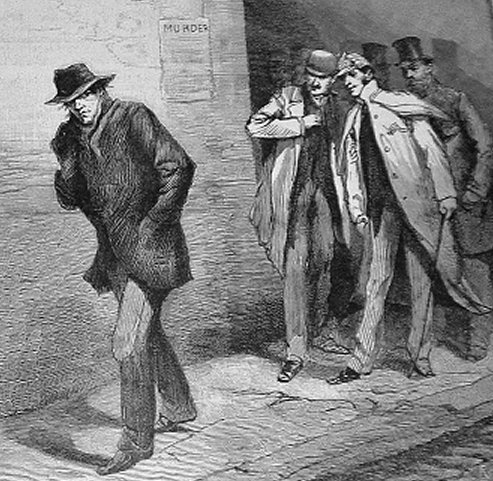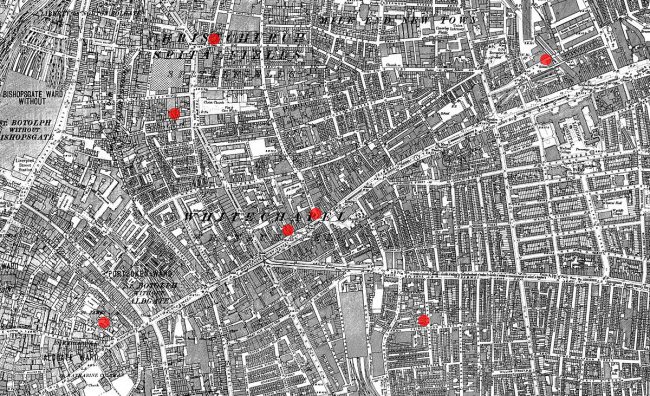
‘With the Vigilance Committee in the East End: A Suspicious Character’ 1888. Illustration about Jack the Ripper. source: Illustrated London News
On August 31, 1888, the mutilated body of Mary Ann Nichols was found in Whitechapel, London. Her death has been attributed to the notorious unidentified serial killer Jack the Ripper and was part of a series of eleven murders that took place between 3 April 1888 and 13 February 1891 in Whitechapel and the neighbouring districts of Poplar, Spitalfields, and the City of London. Despite the mundane nature of crime against women, they have emerged particularly because of their cruelty. Nine of the eleven women murdered are certain to have been prostitutes. The vast majority of experts and researchers see the actions of a single person in five murders, also called “Canonical Five”. Whether the remaining six people were also victims of this murderer or whether one or more others were at large is controversial.
The Dear Boss Letter
The name Jack the Ripper comes from the so-called Dear Boss letter, which was delivered to the Central News Agency in London on September 27, 1888, but the authenticity of which is rather controversial to this date. The author of the letter impersonated the killer. It was often claimed that the name Jack the Ripper was given to the world by the newspapers. Besides this most famous name, the alleged serial killer was also called Leather Apron and The Whitechapel Murderer.
The Whitechapel Murders
The murders took place between August 31st and November 9th in 1888, which was a difficult year for the city of London and its citizens. The Whitechapel area was way too overcrowded, the economy faced bad times and the area transferred into a tough living place filled with violence, crime, alcoholism, racism, and prostitution.

Streetmap showing the locations of the first seven Whitechapel Murders
Mary Ann Nichols was found dead on Buck’s Row (now Durward Street) in Whitechapel at 3:40 a.m. on August 31, 1888. Her throat was cut. In the groin area, incisions were made to open the abdomen and expose their intestines.
Annie Chapman‘s body was discovered on September 8, 1888 in the backyard of 29 Hanbury Street, Spitalfields. Her throat was slit with two incisions. The abdomen was fully opened and disembowelled. The intestines were over her right shoulder. Later it turned out that part of the abdominal wall and the entire uterus were missing.
Elizabeth Stride was murdered on 30 September 1888 on the night of the so-called double event. Her body was found at 1:00 am at Dutfield’s Yard on Bern Street (today: Henriques Street) in Whitechapel. Unlike Mary Ann Nichols and Annie Chapman, Stride was not further mutilated with the exception of throat slitting. Some sources assume that Stride is not one of the victims of Jack the Ripper due to the lack of opening of the abdomen. However, both time and place as well as the victim’s characteristics are consistent with the other murders. Sources who believe that Jack the Ripper was the killer believe that the offender was disturbed by the arrival of the waiter of an adjoining restaurant with a cart.
Only 44 minutes later, Catherine Eddowes‘ body was found in Mitre Square, City of London, about a kilometre away. Her body was as mutilated as Annie Chapmann’s. Half of the uterus and the left kidney were missing from the opened abdomen. In addition, the face was mutilated as well as the throat that had been cut. Then the Ripper probably fled back to Whitechapel, because a part of Eddowes’ apron was later found on Goulston Street. Assuming that both were killed by one person, the murderer of Catharine Eddowes may have accomplished what he was unable to do with Elizabeth Stride due to the disturbance.
On November 9, 1888 at 10:45, Mary Jane Kelly‘s body was discovered in her room at 13 Miller’s Court on Dorset Street. As with all of the Canonical Five, the throat was cut. The face was severely mutilated, the chest and abdomen were cut open. Many internal organs had been removed and were scattered throughout the room. The muscle flesh was removed from various parts of the body. The heart was missing and was either taken by the perpetrator or burned in the oven on site. The murder of Mary Jane Kelly differs from the other victims in that Kelly was much younger and was murdered not in public but in her private quarters. For this reason, some experts believe Mary Jane Kelly was not killed by Jack the Ripper. The majority of researchers, on the other hand, see her as the victim of Jack the Rippers. Time and social class fit into the picture. The fact that the mutilations got worse from murder to murder also speaks in favour of it. Because of the extensive reporting and investigation by police and vigilantes, the killer may have felt compelled to exercise caution and murder Mary Jane Kelly in a protected room away from the public.
After the Last Killing
After the last killing of Mary Jane Kelly, Leather Apron suddenly stopped, and until today the reason is unknown. Experts assume, that he died himself or was imprisoned for a different reason. The investigation took many months, about 2,000 people were interviewed and several hundreds were checked, but the police stayed unsuccessful. The people, who witnessed the victims having contact to men on the dates of their killings delivered mixed images of the murderer. The descriptions varied from shabby to upper class and from long haired to bald. Many investigators claimed the murderer was a slaughterer, but this speculation was never proven true or false. Through the time of investigations, the people’s fear increased and so they founded the ‘Whitechapel Vigilance Committee‘, a group of volunteers looking for suspects and accomplishing independent investigations, but also without success.
Jack the Ripper’s Media Attention
Jack the Ripper’s media attention grew and by the end of 1888, the case was known world wide. The police was not willing to hand over their investigation efforts to the newspapers, which led to them making up important information on their own and increasing the sensation of the story, but also the citizen’s fears. During the investigation, the police received numerous letters considering the case, only three of them became famous, but up to this day it is not clear whether the letters were written by the killer or in reality by journalists.
Even tough the killings took place more than a century ago, the myths continue and several movies and musicals take the cruel events into the field of entertainment. There are even guided tours through London’s East End explaining every bit of the still unsolved case of Jack the Ripper.
Profiling a Killer – Professor Glenn D Wilson, [6]
References and Further Reading:
- [1] Complete History of Jack the Ripper, Philip Sugden, Robinson (2002)
- [2] Jack the Ripper Webpage
- [3] Jack the Ripper at Wikidata
- [4] Raymond Chandler and the Invention of the Hardboiled Detective Novel, SciHi Blog
- [5] Elementary, my Dear Watson! – Sir Arthur Conan Doyle and his famous Sherlock Holmes, SciHi Blog
- [6] Profiling a Killer – Professor Glenn D Wilson, 2012, Gresham College @ youtube
- [7] Begg, Paul (2003). Jack the Ripper: The Definitive History. London: Pearson Education.
- [8] Evans, Stewart P.; Rumbelow, Donald (2006). Jack the Ripper: Scotland Yard Investigates. Stroud, Gloucestershire: Sutton Publishing.
- [9] Lynch, Terry; Davies, David (2008). Jack the Ripper: The Whitechapel Murderer. Hertfordshire: Wordsworth Editions.
- [10] Timeline of serial killers, via Wikidata





